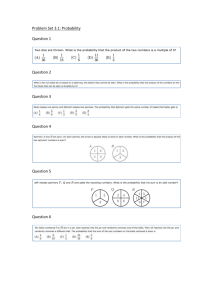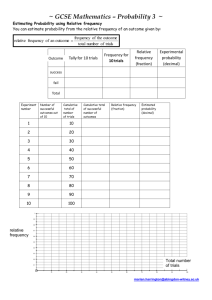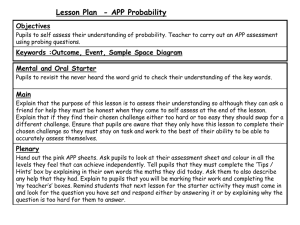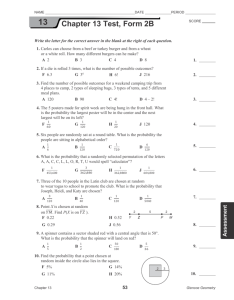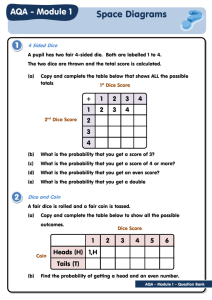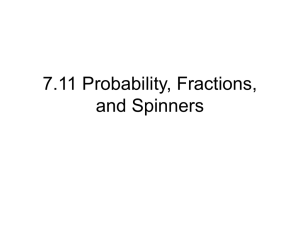Document
advertisement
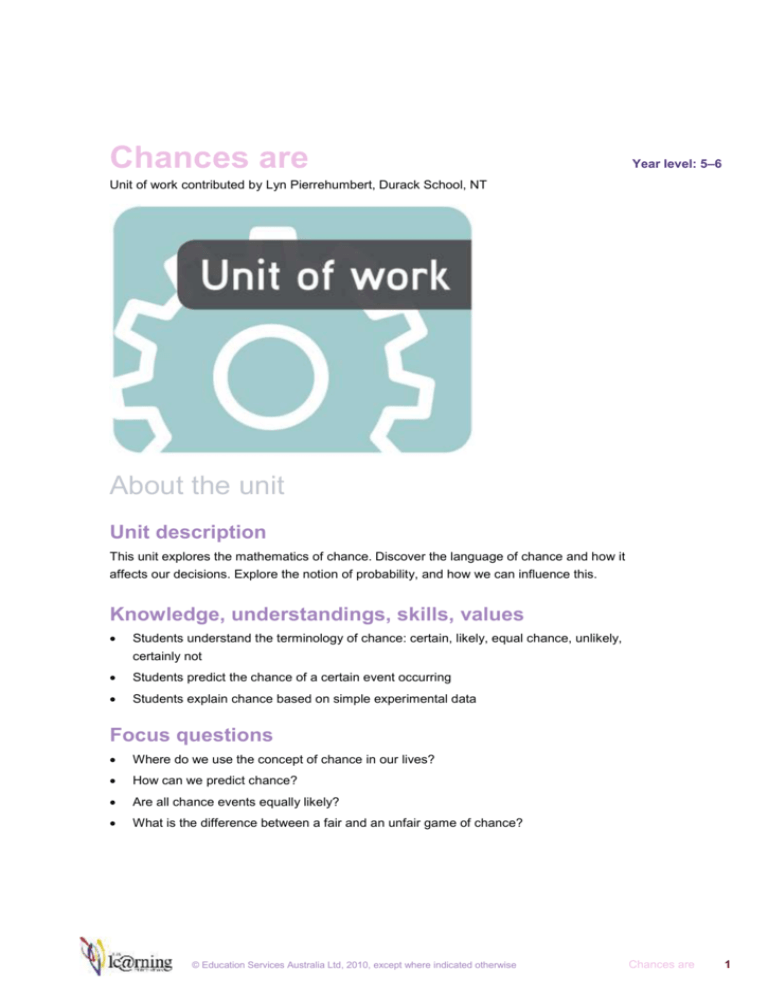
Chances are Year level: 5–6 Unit of work contributed by Lyn Pierrehumbert, Durack School, NT About the unit Unit description This unit explores the mathematics of chance. Discover the language of chance and how it affects our decisions. Explore the notion of probability, and how we can influence this. Knowledge, understandings, skills, values Students understand the terminology of chance: certain, likely, equal chance, unlikely, certainly not Students predict the chance of a certain event occurring Students explain chance based on simple experimental data Focus questions Where do we use the concept of chance in our lives? How can we predict chance? Are all chance events equally likely? What is the difference between a fair and an unfair game of chance? © Education Services Australia Ltd, 2010, except where indicated otherwise Chances are 1 Resources The Le@rning Federation digital curriculum resources The vile vendor series: L211 go figure, L118 questions, L168 best guess Dice duels series: L2323 airport addition, L2635 fair or unfair, L3672 load a pair of dice Spinners series: L3546 Spinners, L2377 Spinners: advanced builders L3515 Coin tossing L5912 Stem-and-leaf graphs: an introduction L3656 Random or not: analyse numbers of jubes (1:1) L8277 Spinners: assessment Equipment dice coins dominoes materials for making games such as coloured card, coloured paper, counters Attached printable resources The following teacher-created learning resources referred to in the Unit of work are available for you to modify, print and use in your own teaching and learning context: Mathematical investigation – spinners Mathematical investigation – fair and unfair games Ready-to-go instructions and game pieces Assessment rubric – posters © Education Services Australia Ltd, 2010, except where indicated otherwise Chances are 2 Teaching the unit Setting the scene Resources L211 The vile vendor: go figure Two dice Assessment rubric – posters (page 13) Teaching and learning activities Use the learning object L211 The vile vendor: go figure to investigate the language of chance and examine examples that illustrate this. Discuss the questions as a group to explore what the student knows about chance and probability. Have students develop a definition and example to illustrate each term, such as the likelihood of a male teacher walking through the door, or the principal declaring a half-day holiday. Have students work in groups to create posters that demonstrate the differences in the language of chance, ie the difference between likely and not likely, certain and not certain and equal chance. These are then presented, explained and displayed for future discussions and reference. Use the Assessment rubric (page 13) to guide students’ planning and creation of their posters. Extension activities Last one standing Students write down three numbers between 1 and 50. These should be numbers they believe are unlikely to be ‘landed on’ when two dice are rolled, added and the cumulative total calculated. Roll two dice, and add the total. If a student has that number, he or she sits down. Roll the dice again, add the total to the previous one and any student with that number sits down. The aim is to be the last one standing. Use a tally system to keep track of the totals over several games to see it there are patterns emerging. Do multiples of seven appear more often than others? Are the totals completely random? Can you accurately predict what the cumulative totals will be? Is there anything you can do to increase the likelihood of your numbers being avoided? Are doubles more frequent? What is the ratio between odd and even totals of the two dice? Use the language of probability to describe the outcomes. © Education Services Australia Ltd, 2010, except where indicated otherwise Chances are 3 Assessment Examine the posters the students produce to determine if they have understood the language of chance. Also look at the examples they have used to demonstrate this. Informal assessment could occur through the teacher asking questions and listening to discussions between students. ~ Have students begin a print or digital learning journal so they can reflect on their new learning and track their progress. Investigating Resources The vile vendor series: L118 The vile vendor: questions, L168 The vile vendor: best guess Dice duels series:L2323 Dice duels: airport addition, L2635 Dice duels: fair or unfair, L3672 Dice duels: load a pair of dice L3546 Spinners, L2377 Spinners: advanced builder L8277 Spinners: assessment L3656 Random or not: analyse numbers of jubes (1:1) L3515 Coin tossing L5912 Stem-and-leaf graphs: an introduction Coins Dominoes Ready to go game instructions and pieces (pages 11–12) Mathematical investigation – spinners (page 9) Teaching and learning activities The vile vendor Revisit the language of chance (likely, unlikely, certain, certainly not and equal chance). On an interactive whiteboard or overhead projector, explore L168 The vile vendor: best guess. Use a vending machine to get a vile-flavoured drink such as cabbage, smelly sock or rusty nail. The machine serves a can of drink randomly from four slots. Work out the likelihood of an event in fraction terms. For example, four ‘fresh fish’ out of a total of four means it is certain that you will get a ‘fresh fish’ drink. ~ Track your successes and failures. Do you get better with practice? Why? In pairs, work through L118 The vile vendor: questions. Students use a vending machine to decide whether the chances of getting a particular drink are impossible, unlikely, equal, likely or certain. © Education Services Australia Ltd, 2010, except where indicated otherwise Chances are 4 Airport addition Explore L2323 Dice duels: airport addition to move planes along numbered lanes on an airport runway. Add the numbers on a pair of dice to determine which plane takes off. Try to predict the lane most likely to clear quickly. Explore how many rolls are needed to match a chosen number five times. Look at an explanation of uneven distributions. Compare the theoretical data distribution with experimental results. Students guess which number would be most common, in order for the plane to take off at the airport. The learning object proceeds to explain the reasoning behind why ‘7’ is a good number to choose and produces a graph to show the reasoning. Numbers up Students work through L2635 Dice duels: fair or unfair, L3546 Spinners and L2377 Spinners: advanced builders. L2635 Dice duels: fair or unfair – Test dice to see if they have been weighted (loaded) to favour one of the six numbers. Explore how many rolls are needed to be reasonably sure of a conclusion. Compare the shape of theoretical data distributions with experimental results. L3546 Spinners – Use a spinner (dial with pointer) and observe how often the pointer lands on each colour. Create your own spinner by changing the colours, names, numbers and sizes of sectors. For example, create a spinner with three purple sectors called ‘Wind’, one red sector called ‘Rain’ and two yellow sectors called ‘Fog’. Test the spinner over a number of spins. Record the results in a histogram (graph). Watch the graph build and the numbers change in the results table after each spin. L2377 Spinners: advanced builder – Use a tool to build coloured spinners (dials with pointers). Choose up to six equal-sized sectors. Choose up to four colours for the parts of each spinner. For example, make a five-part spinner with two blue sectors, two yellow sectors and one green sector. Test the spinner over a number of spins. See what colour the pointer lands on each time. Watch the graph build and the numbers change in the results table after each spin. Compare the actual results with the expected results. Examine these objects as a group at the end of the session, and discuss what students discovered about each. Ready to go Students need a set of the Ready-to-go game pieces (page 12) per player, an instruction sheet (page 11) and a set of dominoes in a cloth bag for each group. Students may cut the game pieces before playing, or it may be less time-consuming to make a permanent set by photocopying the items onto card, cutting them out and laminating them. As they play, have them tally the number of draws each has before filling their bag and the total number of draws altogether. ~ When they have completed the game, have students discuss the following questions. Was the drawing of the dominoes determined by chance or luck? © Education Services Australia Ltd, 2010, except where indicated otherwise Chances are 5 Was a particular number more likely to be drawn than another? Could the chances of this be influenced in any way? Spread the dominoes out face up and, using the terminology of certain, likely, equal chance, unlikely or impossible, determine the chances of drawing a particular tile. Are you more likely to get a double than a 7, or other number? ~ As a class, explore L5912 ‘Stem-and-leaf graphs: an introduction’. Plot the number of draws on a stem-and-leaf graph and diagnose the results. Work out the ‘mean’ ‘mode’ and ‘median’ of this data set. If this game were to be set up as a fundraiser, use the data to determine how many rolls would win a prize, ensuring that the stall owner would still make a profit. Extension activities Probability Discuss the chances of rolling a six then another six with dice, or tossing a head then another head when tossing coins. Students are to pose a question regarding the rolling of dice or tossing of coins. Then they are to explore how this can be worked out, and give it a try. Write the possible combinations on the whiteboard. ~ Explore the concept further using L3515 Coin tossing. Toss a coin 100 times and watch the dynamic graph of the results. See the longest run of heads. Set two out of three possible parameters such as the number of tosses, the longest run of heads and the probability of heads. Notice the variation in runs and the tendency to the theoretical probability. Discuss the likelihood of winning a lottery. A random chance? Complete the learning object L3656 Random or not: analyse numbers of jubes (1:1). Test a machine that randomly packages two types of fruit jubes: penguin or frog. Notice that each jube type is equally likely to be produced within a packet of 12 jubes. Look at patterns in numbers of jube types, such as 5 penguins and 7 frogs (the most common in this sample). Analyse the results of large samples. Compare the number of the most commonly occurring jube type. Identify the most likely number of the most commonly occurring jube type. ~ Work through L3672 Dice duels: load a pair of dice. Make biased dice. Weight (load) dice to favour one of the six numbers. For example, load the number five on both dice so that it is three times more likely to come up than any other face. Test ideas about bias by rolling the loaded dice. Examine the sum of the two numbers rolled. Look at demonstrations of the mathematical principles to analyse the bias. Compare the shape of theoretical data distributions with experimental results. © Education Services Australia Ltd, 2010, except where indicated otherwise Chances are 6 Test your understanding of chance by constructing coloured spinners (dials with pointers) according to given criteria in the learning object L8277 Spinners: assessment. Choose up to 12 equal-sized parts. Choose up to three colours for the parts of each spinner. There are 16 different tasks. For example, make a red and blue spinner with seven parts so that the chance of spinning red is less than spinning blue. Or, choose the number of parts and make a spinner that is likely to spin 20 per cent red, 40 per cent blue and 40 per cent yellow. Assessment After exploring L3546 Spinners and L2377 Spinners: advanced builder, students produce a spinner that fits a given criteria. The students research the different types of spinners and then give reasons for why they chose the one they did. Using Mathematical investigation – spinners (page 9), students must test their spinner and write up a tally and explanation of their results to see if, in fact, the spinner fits the criteria specified. The criteria can be adjusted to give more able students a more challenging problem. Bringing it all together Resources Mathematical investigation – fair and unfair games (page 10) Teaching and learning activities Game on As a class, students should brainstorm some games they are familiar with. Categorise the games into games of chance, games of skill, or both. Students make up two games of chance using two dice – one where the player has an equal chance of winning, and the other where it is less than 25 per cent. The students can then play these games and each player offers written feedback about what worked well and what needs improvement. Encourage them to suggest a solution for any problems. Have students complete Mathematical investigation – fair and unfair games (page 10) and compile the feedback sheets from their peers. Assessment Have students reflect on what they have learned in their learning journals, particularly the problems they faced when creating their games. Because there is some research to suggest that students of this age are not open to feedback from peers, have them reflect on issues such as: Were they encouraged or offended by the feedback of their peers? Were they prepared to accept it and make any changes? When they offered feedback did they focus on the game or its maker? Would they prefer to work in a group and be assessed as part of the group, or as an individual? © Education Services Australia Ltd, 2010, except where indicated otherwise Chances are 7 Writer: Lyn Pierrehumbert The material in this Unit of work may contain links to internet sites maintained by entities not connected to Education Services Australia Ltd and which it does not control (‘Sites’). Education Services Australia Ltd: provides the links for ease of reference only and it does not sponsor, sanction or approve of any material contained on the Sites; and does not make any warranties or representations as to, and will not be liable for, the accuracy or any other aspect of the material on the Sites or any other matter connected to the use of the Sites. While the material in this Unit of work is not remunerable under Part VB of the Copyright Act 1968, material on the Sites may be remunerable under Part VB of the Copyright Act 1968. It is your responsibility to read and comply with any copyright information, notices or conditions of use which apply to a Site. © Education Services Australia Ltd, 2010, except where indicated otherwise Chances are 8 Mathematical investigation – spinners Name Class Date Investigation Make and test a spinner that you think is most likely to stop on red, least likely to stop on green and have the same chance of stopping on blue as yellow. You are not to weight your spinner. In your report say what you did and what you found. Include a table in your report. Setting out of report Title page Full name, class, teacher and title. Orientation In sentences, define the problem. Initial ideas Write and use diagrams to explain how you will go about the assignment. Research different types of spinners and describe the style of spinner you have chosen to work with. How I did it Describe what you actually did to construct and use the spinner in detail, including all equipment and materials used. Your explanation should be written so that someone else could read and repeat the same investigation. Describe the methods used to test your spinner. Results Show all the results of your spinner tests in a tally and/or table form. Attach your spinner to your report. Discussion Discuss what your results mean. Did you make a spinner that fitted the criteria? Describe any problems you had carrying out your investigation. Conclusion Write a brief statement about your investigation and its findings. © Education Services Australia Ltd, 2010, except where indicated otherwise Chances are 9 Mathematical investigation – fair and unfair games Name Class Date Investigation Students are to make up two games of chance using two dice. One where the player has an equal, ie 50 per cent, chance of winning, and the other where is it less than 25 per cent. Setting out of report Title page Full name, class, teacher and title. Orientation In sentences, define the problem. Initial ideas Write and use diagrams to explain how you will go about the assignment. What games of chance have you thought about? How I did it Describe what you actually did to make the games of chance, including all equipment and materials used. Your explanation should be written so that someone else could read and repeat the same investigation. Describe the methods used to test your games. Results Show all the results of your tests in a tally and/or table form. Attach your games or diagrams/pictures of your game to the report. Discussion Discuss what your results mean. Did you make a game that fitted the criteria? Describe any problems you had carrying out your investigation. Conclusion Write a brief statement about your investigation and its findings. © Education Services Australia Ltd, 2010, except where indicated otherwise Chances are 10 Ready-to-go instructions Help Li get ready for school. Li needs to pack: a sandwich for lunch fruit for a morning snack coloured pencils writing homework a ruler a book to read sports shoes basketball Use the dominoes to be the first to collect everything Li needs to take to school. How to play 1. You will need a set of game pieces for each player (see next page) and a set of dominoes. 2. Place the game pieces on the table and the dominoes into a cloth or paper bag. 3. Take turns to take a domino from the bag. Put the domino back in the bag and shake it after each turn. 4. You can start collecting Li’s belongings once you pick a double. 5. Add up the two sides of the domino to give you the domino total. 6. To keep building you need to get the domino totals in the order given. If you get a number you cannot use you must wait for your next turn. 7. If you get a double 2 or 4 you can pick up the next piece you need. 8. The winner is the first person to get all the pieces required. Piece Domino total Piece Domino total 1. Li Any double 6. Basketball 5 2. Sandwich 1 7. Book 6 3. Fruit 9 8. Pencils 7 4. Homework 3 9. Ruler 8 5. Shoes 10 © Education Services Australia Ltd, 2010, except where indicated otherwise Chances are 11 Ready-to-go game pieces © Education Services Australia Ltd, 2010, except where indicated otherwise Chances are 12 Assessment rubric – posters Category A B C Purpose The purpose of the poster is immediately obvious. Viewers can understand and interpret its information. The purpose of the poster is obvious. Viewers can obtain basic information. The purpose of the poster is unclear. Viewers can only obtain limited information. Information The information: is accurate is original is complete, clear and concise provides extra relevant content. The information is: mostly accurate a mix of original and copied complete, clear and concise. The information is: inaccurate in places copied limited, irrelevant and unclear. Audience The design, content and language shows an awareness of the needs of the intended audience and meets these very well. The design, content and language meets the needs of the intended audience. The design, contents and language shows little regard for the needs of the audience. Design All design elements are included and contribute to the message. Titles and subtitles are clear and enhance readability. Layout enhances information. Text is clear, readable and varies in size to enhance presentation and understanding. Colours, patterns and borders carefully chosen and used. Most design elements are included and contribute to the message. Titles are clear and readable. Layout is balanced and attractive. Text is readable. A range of colours, patterns and borders is used. Some design elements are included but they add little to the meaning of the main message. Titles and text are indistinguishable. Layout is messy. Text is illegible. Colours, patterns and borders used indiscriminately. Text Well-written, organised and easy to understand. Grammar, spelling and punctuation are all correct. Adequately written and organised and reasonably easy to understand. Grammar, spelling and punctuation are mostly correct. Poorly written, disorganised and message is not clear. Little attention has been paid to grammar, spelling or punctuation. Graphics Graphics are original, relevant and add extra information to the text. Graphics are relevant and support the text. Graphics are copied and do not relate to the text. Publishing Publication is in an appropriate medium and of a very high standard. Publication is in an appropriate medium but needs greater attention to detail. Little thought has been given to the medium and standard of publication. Appeal The poster is eyecatching and immediately attracts attention. Its topic can be determined from a distance. The poster has eyecatching elements and its main message can be determined quickly. Poster does not stand out and main message is unclear. © Education Services Australia Ltd, 2010, except where indicated otherwise Chances are 13
